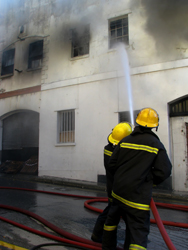Exploiting man and machine in search and rescue operations
Coordinating the interaction between human and non-human entities in a common environment presents a number of challenges. Yet much could be gained from combining the diverse capabilities of man and machine. This was the objective of PELOTE, a pioneering RTD project funded by the Information Society Technologies Programme. Informatics specialists with the University of Wuerzburg in Germany, a participant in the PELOTE project, developed a new concept for knowledge sharing. The application involved search and rescue missions in buildings on fire. The aim was to move beyond current static fire rescue maps that frequently contain too much information and present them in a coherent fashion. The solution was a new prototype Search and rescue map (SRM). The building's ground plan was stored in digital format. Information concerning fire exits, sprinkler installations and the location of toxic and flammable materials is then added as separate layers over the ground plan. Each user in the system can access the specific data they require from a centralised database at any given time. Knowledge can also be shared directly between humans and robots taking part in the rescue exercise. The experience acquired during PELOTE revealed that the most important variables were an entity's status (for example, busy, free, in need of assistance.), its position on the SRM and its intended path. In the case of missing entities, it was possible to determine their location through triangulation when the distance to known entities was available. The SRM database could be housed at local search and rescue centres and individual SRMs retrieved in emergency situations. Further tests of this approach are planned in the context of the PELOTE project.







